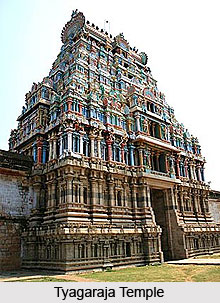 The Thiruvarur is a city in the east of Tamil Nadu, roughly halfway between the northern and southern borders. It is very popular for its rich architecture and many features of Chola art in its temples, which is dedicated to Achaleshwara. It is also well known for the annual chariot festival, which is held in the month of April. The Tyagaraja temple of Thiruvarur has the fine Chola cravings of Ardhanari, Durga, Bikshatanar and Nataraja on the walls. There are also sculptures of Brahma, Lingodbhava and Dakshinamurthi. Tiruvarur is also the birthplace of the Carnatic Music Trinity of Tyagaraja, Muthuswami Dikshitar and Syama Sastri.
The Thiruvarur is a city in the east of Tamil Nadu, roughly halfway between the northern and southern borders. It is very popular for its rich architecture and many features of Chola art in its temples, which is dedicated to Achaleshwara. It is also well known for the annual chariot festival, which is held in the month of April. The Tyagaraja temple of Thiruvarur has the fine Chola cravings of Ardhanari, Durga, Bikshatanar and Nataraja on the walls. There are also sculptures of Brahma, Lingodbhava and Dakshinamurthi. Tiruvarur is also the birthplace of the Carnatic Music Trinity of Tyagaraja, Muthuswami Dikshitar and Syama Sastri.
It is said that Vishwakarma, the divine architect, made the idol of Vishnu of Tyagaraja temple without the use of the chisel. The Sanskrit name of chisel is `Vitanka` and hence it is known as Thiruvarur as a Vitanka Sthala. Here, a monument can be found, which was built to immortalise the king Mani Neeti Chola. There is a story related to this king, who was supposed to provide equal justice to all in his kingdom. It is said that the king punished his own son who had killed a calf under the wheel of his chariot. The king was fair to the cow that rang the bell of justice. A sculpture in the Tyagaraja temple of Thiruvarur depicts the cow running the chariot over the prince for justice. The temple complex has shrines dedicated to Vanmikanathar, Tyagarajar and the Kamalaamba, and covers an area of over 20 acres.
There is also a belief that the main deity of the Tyagaraja temple of Thiruvarur, Sri Tyagaraja is performing the ajapa natanam. He is in the form of a Somaskanda Murthy with Uma on one side and Skandar in the middle. It is said that Vishnu worshipped Siva in the form of a Somaskandar. Siva is said to have appeared in the anthill or Valmikalinjjam. This is considered as the oldest part of the temple.
An interesting story is said about Muchukunda, the Chola ruler of Thiruvarur. There is a fable that a monkey dropped `bilva` leaves on the Siva Linga below the tree without realizing the fact. But Siva was pleased with his innocence and blessed him. The monkey took rebirth as the king Muchukunda but with his monkey face and he also retained the memory of his earlier life. According to the history of Thiruvarur, the image of Tyagaraja in the temple is one that Muchukunda picked up out of the seven idols given by Vishnu to Indra and he needed to give one to Muchukunda who helped him. Indra was not willing to give the idols so he made the identical idols to confuse Muchukunda. But as the king chose the correct one he gave him the rest of the idols as well.
The paintings of the king Muchukunda can be seen on the ceiling of the thousand-pillared mandapam created in the late 17th and late 18th centuries during the Kayak period in Tanjavur. It depicts Muchukunda as a friend of Indra and his ally against the Asuras. He can be seen riding a procession of elephants. There is also one more picture, which shows Muchukunda praying to Vishnu in the ananta sayana posture. The festival of Tyagaraja is also portrayed showing a display of fireworks. It is mentioned in many Dikshatar kritis. The other six images were kept in different places within the territory and together they are referred to as the Sapta Vitanka Kshetras. Each idol of Tyagaraja has a unique name and a unique type of dance associated with it.
The Kshetras are:
• Thiruvarur - Veeti Vitanka - ajapa natanam
• Tirunallar - Naga Vitanka - unmatta natanam
• Tirunagi (Nagapattinam) - Sundara Vitanka -paravara taranga natanam
• Tirukkaraivasal - Adi Vitanka - kukkuta natanam
• Tirukkuvalai - Avani Vitanka - bhramara natanam
• Tiruvaymur - Neela Vitanka - kamala natanam
• Tirumaraikkadu - Bhuvana Vitanka -hamsapada natanam.



















